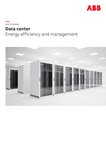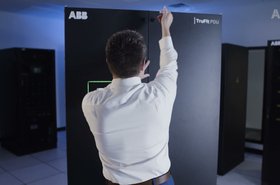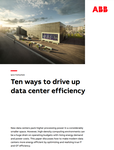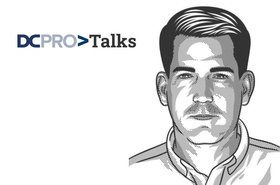When Charles Brown and Walter Boveri set-up in business in 1891 as manufacturers of electrical technology they probably never imagined that not only would it still be around at the cutting edge more than 130 years later, but that it would become one of the biggest companies in the world supplying high-tech markets that didn’t even exist back then.
After all, how many companies established in the 19th Century are even around today, let alone as well-known and trusted as ABB, which still bears their initials in its name?
But whereas back in the 1890s Brown & Boveri produced components for electrical motors, today it produces power systems for the world’s biggest data centers – and much else besides.
“We make everything from substation to socket,” says Narain Chandwani, sector manager – data centers, at ABB. “And underlying everything we do is enabling smart and sustainable electrification.”
That electrification encompasses the entire range of power distribution, substations, critical power, white space electrical components, installation products, cooling systems and even alternate power sources. Even the electric vehicle charging infrastructure in the car park is covered.
Moreover, with the global push towards net-zero, not to mention the standard business demands for ever-greater efficiency, these systems must also be smart and manageable.
Health and efficiency
For all the talk and column inches expended on data center sustainability, improvements to data center power usage effectiveness (PUE) figures have waned over the past decade. Having declined rapidly from an average of 2.5 in 2007 to just over 1.6 in 2013, the dial has barely shifted at all since then.
Data center operators, therefore, will need try a lot harder over the next decade if they’re to achieve net-zero by their self-imposed deadlines of 2030 or 2035 without resorting to sophistry or questionable carbon offset projects. But the ABB white paper, Data Center Energy Efficiency and Management, provides a step-by-step way forward, says Chandwani.
The first step, he says, is simply to ensure that PUE is accurately measured. Even small variations in the data upon which it is based can make a significant difference. “PUE is still a widely used metric in the industry, yet what it doesn’t really capture is the efficiency of the IT itself. That’s the main disadvantage – it doesn’t reflect any efficiencies from the IT,” says Chandwani. However, he says, while compute demands are never going to decline, data center operators can ensure that its various elements are working at maximum efficiency.
“On the compute side, you should not be wasting power by virtualizing data centers: instead of having one server per application you can have multiple applications running on the same server. You don’t want your server idling because even under those conditions it’s still consuming 30 to 40 percent of its graded power,” says Chandwani.
Then, he adds, areas of power waste need to be identified. “I would say you have to optimize energy use, not minimize it. You’re not wasting energy running servers at 50 percent of their load, rather than 10 or 15 percent lower.”
Moreover, by optimizing server loads cooling can be optimized, too – the second biggest area of power consumption in any data center.
In addition to optimizing server loads, advises Chandwani, data center operators ought to optimize CPU (and GPU) temperatures. Quite simply, he says, many data center engineers crank up the cooling to be on the safe side, but modern chip technology can comfortably handle temperatures of up to 85 degrees. Moreover, for data centers looking to reuse waste heat, such temperatures are far more useful for district heating schemes or whatever reuse plans they have, making it a win-win.
“That means a substantial saving in your cooling power because the load on the cooling infrastructure is reduced,” says Chandwani.
Drilling down
The ABB white paper goes into even more detail, area by area, starting with monitoring. The old saying, “You can’t manage what you can’t measure” obviously starts with accurate and reliable data.
The white paper suggests installing devices for measuring, monitoring and securely communicating this data all the way from the main distribution board to the UPS, and including the backup infrastructure. This can be achieved with ABB’s CMS 700 range of circuit monitoring systems, which can measure both AC and DC. It consists of a control unit and sensors, allowing easy monitoring of the individual lines of a facility.
Up to 96 of these sensors can be installed on existing systems, and they support standard Modbus RTU, Modbus TCP/IP and SNMP v1, v2 and v3 communications protocols.
Rolling out such monitoring systems on existing data center infrastructure is arguably as valuable as rolling it out in a new data center. When the data center is extended, new servers and racks installed and the usual piecemeal upgrades are rolled out, the opening day PUE figure can significantly decline, and reliability can be affected, too.
But with the right high-precision monitoring and management excessive consumption can be identified – right down to the items of equipment responsible – and action quickly taken, helping to push down PUEs rather than letting them drift upwards.
However, there’s more that can be done with this data than just squashing excessive power consumption. It also enables predictive maintenance, which ABB calculates can save up to 43 percent on maintenance costs for each device, as well as helping to maintain valuable five-nines reliability figures.
“Predictive maintenance is based on the information from the devices, such as environmental conditions, operating conditions, events and the effect of performance maintenance, and a complex algorithm that runs in the cloud through ABB Ability Electrical Distribution Control System (EDCS),” explains the white paper.
This is on top of the alarms that would automatically be raised should devices themselves detect any abnormal conditions.
ABB’s devices also have power quality meters embedded and measurements can, therefore, be performed at any point in the data center power supply distribution.
Indeed, the final big win comes in identifying distribution losses, with ABB offering equipment that can squeeze distribution losses down to five percent or less, thanks to precise information from ABB’s devices. The issues that may be causing such losses can also be more easily identified and fixed.
“IT equipment installed in data centers can produce power quality issues causing harmonic distortion in the network. Harmonics will cause additional losses and reliability issues. These can be overcome by placing suitable filters inside the network. However, to correctly select and locate the filters, it is necessary to have the right information about the source and level of the harmonic distortion,” advises ABB.
Various other aspects of power quality can also be monitored at the same time by the same devices, including average voltage, spikes or short interruptions, voltage imbalances between phases and various other issues that may affect energy efficiency and reliability.
End of life
But what about ABB itself? Soon, every organization in the world will be focusing on their Scope 3 emissions – the carbon emissions embodied by the goods and services acquired from suppliers – and this will arguably be one of the biggest challenges in the net-zero journey.
Here, again, ABB is well ahead of the pack.
ABB started its environmental reporting as far back as 1994, says Chandwani, and expanded that to sustainability reporting in 2000. “And we have published our first integrated sustainability report this year,” he adds. “This report combines the company’s economic, social and governance performance in one transparent report.
“It doesn’t just cover the financials and business aspects of the company, but also provides transparency on the non-financial side, such as ABB’s social and governance performance, with the aim of demonstrating continuous performance in ESG [environmental, social and governance] across the company.”
But what has ABB actually done in real terms? According to Chandwani, since 2019 alone the company has reduced its own carbon emissions by 65 percent, and has provided its tier one suppliers with the target of achieving 50 percent reductions by 2030.
That is underpinned by ABB’s adoption of ISO 14025, which requires audit and certification to verify the company’s sustainability measures. “It’s basically a cradle to grave process from manufacture to end of life. We have to independently verify our operations, so that we can provide declarations and proof of compliance to customers and suppliers.”
Under ISO 14025, ABB produces compliant environmental product declarations (EPDs) for individual products so that customers are able to compare the sustainability credentials of ABB products against rivals – provided that those rivals, too, are also ISO 14025 compliant, of course. Many have yet to catch up.
This global standard is underpinned by the methodologies established in the ISO 14040 lifecycle assessment (LCA) tool.
A key part of sustainability isn’t about power use, using cardboard instead of plastic in packaging, or taking the bike to work instead of the car, but the recyclability of equipment at end of life, and reducing the level of waste going to landfill.
“We’ve achieved a 32 percent reduction in the amount of waste going to landfill since 2019. The number of recycling and waste reduction projects that we have implemented since 2020 is now 160 across the world because we are, after all, a global company,” says Chandwani. Indeed, with one product ABB has even reached a rate of 76 percent recyclability.
All this will go a long way to helping data center operators achieve their own Scope 3 carbon emission reductions – and much more besides.
“Ultimately, net-zero isn’t a destination, it’s a journey and we all need to make sure that we stay on track,” says Chandwani.
Indeed, net-zero won’t be a one-and-done mega-project, but an activity that will require ongoing effort.
But working with partners that have demonstrated a long commitment, not just to sustainability, but market leading products and services going back more than a century, ought to make that journey a little bit easier.
More...
-

Data center energy efficiency and management
A whitepaper looking at the essentials of energy efficiency and data center monitoring and management
-

Sponsored ABB TruFit power distribution unit provides rapid, space-saving solution for data centers
ABB Electrification continues to support the rapid roll-out and scaling of data centers with the launch of a next-generation three-phase power distribution unit
-

Ten ways to drive up data center efficiency
This new report from ABB discusses how to make modern data centers more energy efficient by optimizing and realizing true IT and OT efficiency



